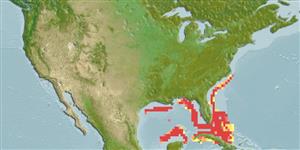>
Ophidiiformes (Cusk eels) >
Ophidiidae (Cusk-eels) > Ophidiinae
Etymology: Lepophidium: Latin, lepus, leporis = rabbit + Greek, ophis = serpent (Ref. 45335); crossotum: Name from Greek 'krossotos', meaning fringed, referring to the condition of the snout tip..
Environment: milieu / climate zone / depth range / distribution range
Ecología
marino bentopelágico; rango de profundidad 91 - 384 m (Ref. 91765), usually 91 - 192 m (Ref. 91765). Tropical; 36°N - 21°N, 96°W - 75°W (Ref. 91765)
Western Atlantic: along the coast of the US from North Carolina (south of Cape Hatteras) to southern Florida and in the eastern Gulf of Mexico from western Florida to Yucatan.
Tamaño / Peso / Age
Maturity: Lm ? range ? - ? cm
Max length : 16.8 cm SL macho / no sexado; (Ref. 91765)
Short description
Morfología | Morfometría
Radios blandos dorsales (total): 117-125; Radios blandos anales: 99 - 106; Vértebra: 68 - 69. This species is characterized by the following: fringed snout; differs from L. kallion and L. wileyi by fewer total vertebrae (67-69 vs. 71-75 and 70-75, respectively) and lateral line length in SL (87.8% vs. 88.8% and 91.5%, respectively); differs from L. kallion in the number of dorsal rays (117-125 vs. 129-137) and anal rays (99-106 vs. 108-114), average post orbital length in HL (48.6% vs. 56%), average orbit diameter in HL (30.9% vs. 25.4%), average body depth at occiput in SL (10.7% vs. 13.3%), at origin of dorsal fin (11.5% vs. 14.5%), at origin of anal fin (10.1% vs. 11.9%), average predorsal distance in SL (22.1% vs. 23.9%), average preanal distance in SL (35.6% vs. 39.6%); head and body color is pale brown and without pattern (Ref. 91765).
Life cycle and mating behavior
Madurez | Reproducción | Puesta | Huevos | Fecundidad | Larva
Robins, C.R., R.H. Robins and M.E. Brown, 2012. A revision of Lepophidium (Teleoastei, Ophidiidae), with descriptions of eight new species. Bulletin of the Florida Museum of Natural History 52(1):1-94. (Ref. 91765)
IUCN Red List Status (Ref. 130435)
Threat to humans
Harmless
Human uses
Más información
Nombres comunesSinónimosMetabolismoDespredadoresEcotoxicologíaReproducciónMadurezPuestaAgregación para la puestaFecundidadHuevosEgg development
Age/SizeCrecimientoLength-weightLength-lengthLength-frequenciesMorfometríaMorfologíaLarvaDinámica larvariaReclutamientoAbundanciaBRUVS
ReferenciasAcuiculturaPerfil de acuiculturaRazasGenéticaElectrophoresesheritabilidadEnfermedadesProcesamientoNutrientsMass conversion
ColaboradoresImágenesStamps, Coins Misc.SonidosCiguateraVelocidadTipo de nataciónSuperficie branquialOtolitosCerebrosVisión
Herramientas
Special reports
Download XML
Fuentes de Internet
Estimates based on models
Preferred temperature (Ref.
123201): 17.5 - 24.4, mean 21.7 °C (based on 37 cells).
Phylogenetic diversity index (Ref.
82804): PD
50 = 0.5000 [Uniqueness, from 0.5 = low to 2.0 = high].
Bayesian length-weight: a=0.00102 (0.00046 - 0.00225), b=3.06 (2.88 - 3.24), in cm total length, based on all LWR estimates for this body shape (Ref.
93245).
Nivel trófico (Ref.
69278): 3.5 ±0.7 se; based on size and trophs of closest relatives
Resiliencia (Ref.
120179): Alto, población duplicada en un tiempo mínimo inferior a 15 meses (Preliminary K or Fecundity.).
Fishing Vulnerability (Ref.
59153): Low vulnerability (11 of 100).
